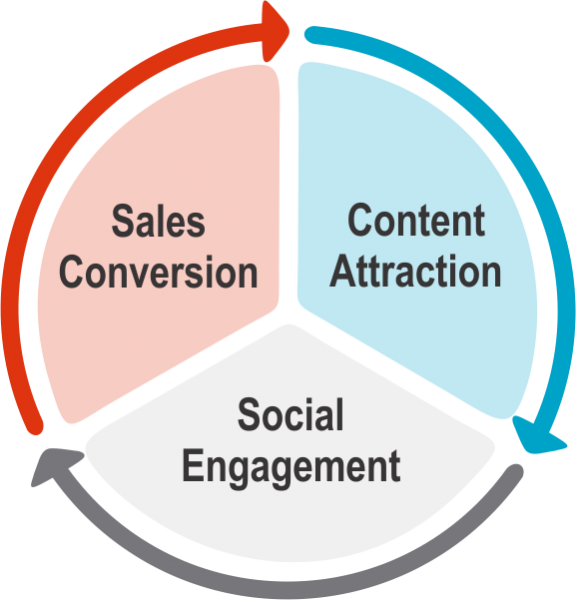
Relationship selling and social marketing are becoming one and the same, and this presents numerous advantages for any business that understands how the two work together. If you hate cold calling and the feeling of interrupting your best clients, then stop selling as you know it and get focused on helping. That’s the heart of relationship selling. To be clear, helping can come in the form of sharing valuable information or introducing new product innovations. Helping is the New Cold CallingWhen I started selling for a large corporation immediately after graduating from college, I did not initially understand my role. I was on the road 3 full weeks out of every month. To be honest, it seemed like I was a professional visitor. The truth is I was practicing relationship selling without even knowing it. One of my goals for the first year was simply not to lose any business, something that can happen when there is a change in the sales team. To make that happen, I did everything I could to help my customers and earn their trust. Is that selling? Traditional selling tends to focus on transactions – moving products and services. Whereas relationship selling assumes that if you continuously earn the trust of the customer they will buy when the time is right. This is the role of your blogging and social media. It informs and educates potential buyers, thereby gradually earning their trust. It’s a new way to sell that happens to work exceptionally well in our digital world. One of the reasons cold calling seldom works is that it is interruptive. Whereas, digital, social marketing is willingly consumed by buyers that want the help. This is one reason why social marketing is the new relationship selling. Relationships are Sustainable: Transactions are NotYou can build a relationship selling process that predictably leads to desired outcomes. The idea is to view every customer interaction as an opportunity to move them from interest to outcome, with that outcome being determined by the buyer – not the seller. Smart companies continuously move their potential buyers and customers to a better place. This used to be the role of the salesperson. Now that it can be accomplished digitally, it can be automated with customer relationship managers (CRM’s) just like the one that delivers this newsletter to thousands of subscribers. The outcome of a relationship selling process is ideally a stronger relationship or a sales transaction. Both are good, but only one is sustainable. Therefore, focus on the continuity of the relationship and let buying become a by-product of that sustained relationship. Investing in Relationships Builds Your BusinessSales transactions are often viewed as the conclusion of the sales cycle, which effectively makes them an ending. Nobody likes endings. A healthier approach is to treat them as events within a continuous process that never ends. When a customer buys they are invested in your company. What is their return on that investment above and beyond the product or service? Many businesses will have to answer zero, because that has traditionally been the standard practice. What happens next is typically a waiting period until the customer buys again. Marketing is designed to make that happen; and so is selling. The business often asks the customer if there is anything they can do to help them. Asking to help is not helping. Helping is proactively giving the customer what they need to be happier, regardless of whether it relates to the business or not. This is relationship selling in this trust economy.
It’s an investment in the collective future of everyone concerned. It’s proactive, continuous, and unlike a transactional approach – it never ends.
|
Relationship Selling in The Trust Economy
The Relationship Selling Mindset

Many years ago one of my best customers asked me an important question after we had concluded our business transaction.
What’s next?
He asked this question for a specific reason, and that was to help me understand how to better help him.
Every business should know what should be happening next in their business. This holds true for those involved with marketing, sales, customer service, or any other role, because these days all of them are interconnected.
Of course, given that revenue is the lifeblood of every company, it is vital that every salesperson knows at all times what should be happening next.
What’s Next?
When my client asked me what’s next I gave an honest response that revealed (like most salespeople) I had a transaction, as opposed to a relationship selling mindset. Here’s that conversation.
Client: What’s next?
Me: What do you mean what’s next, we’re done.
Client: You don’t get it do you?
Me: I guess I don’t. Help me understand.
Client: What’s next! Upgrade me. Make improvements. Take something out and replace it with something else that is new and better.
In so many words, my client was giving me permission to spend more of his money!
When you have a transaction mindset there is a tendency to think of your relationships with customers as a series of transactions, with gaps in between. This is understandable, because that’s how most traditional sales training programs are structured.
What’s happens after the sale? Traditionally, that is customer service. Following up to make sure the client is happy. However,
Immediately after a sale is an outstanding time to make offers for new business. Tweet this
A transactional mindset focuses on moving products and services. When this happens, it is difficult to distinguish one company from another. Why? Everyone is selling the same stuff.
The best solution naturally arises in in every selling situation when the business focuses on relationships. This may begin with sharing new information, but that in turn could lead to additional purchases.
This is precisely why I’m convinced content and social marketing is the new relationship selling.
Invest in the Relationship
Given that more than 50% of all relationships eventually fail, is it any wonder that traditional selling does not work?
How much healthier could your business be if relationships with its customers were stronger?
One of the smartest business building strategies is designing systems that give customers more of what they want. This will necessarily be different for every customer, but generally speaking it will be whatever makes them happier.
Customers are happy when they get what they want. The challenge is discovering what that is, which should be part of your process.
Help Customers Do More of What They Want to Do
The old school method of helping customers was to simply ask, “How can I help you.”
“Make me happier” may be the most honest response to that question. It could also lead to some interesting conversations, so feel free to give it a try.
It’s up to the business to have systems in place that demonstrate its capabilities for taking its customers to a better place in life. This is your business mission.
If you are serious about that mission, then you should always be thinking of ways for helping your customers. Naturally you want them to buy your products and services, but there are countless other ways to help them too.
This is the role of your content marketing. It’s the role of your relationship selling. If you have a valid strategy and a system for implementing it, you always know what’s next.
When I fast forward from that earlier conversation to the present, I know exactly what’s next. It is a derivative of one or a combination of these three direct influences of social media and our greater connectivity in general, that are shaping our business environment these days.
Business is Now Personal – Leverage the power of the personal brands. Listen to customers. Understand what they want and help them get it.
Markets are Collaborative – Stop selling and start collaborating with buyers. Bring your experience and expertise to the table, combine it with their desires, and see what you can co-create.
Communities are the New Markets – We all live and work in communities. The more involved and helpful you are within yours, the better your business will understand what people want and how you can help them get it.
Want to grow your business?
Stop selling stuff and really tune into your customer relationships. Tweet this
Relationship selling is the topic of this month, so come back for more insights.
Please share your thoughts in a comment.
About the Author: Jeff Korhan, MBA, is the author of Built-In Social: Essential Social Marketing Practices for Every Small Business – (Wiley 2013)
He helps mainstream businesses adapt their traditional growth practices to a digital world. Connect with Jeff on LinkedIn, Twitter, Facebook, and Google+.


